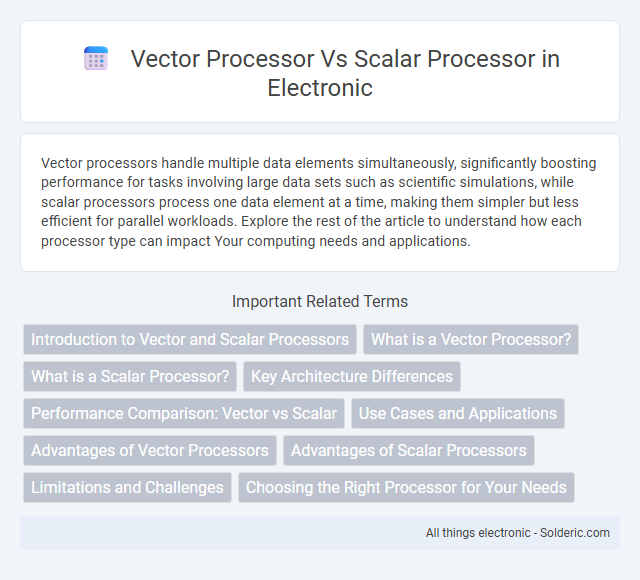Vector processors handle multiple data elements simultaneously, significantly boosting performance for tasks involving large data sets such as scientific simulations, while scalar processors process one data element at a time, making them simpler but less efficient for parallel workloads. Explore the rest of the article to understand how each processor type can impact Your computing needs and applications.
Comparison Table
| Feature | Vector Processor | Scalar Processor |
|---|---|---|
| Definition | Processes multiple data elements in a single instruction (SIMD architecture). | Processes one data element per instruction (SISD architecture). |
| Data Handling | Operates on vectors (arrays) of data simultaneously. | Operates on individual scalar data elements sequentially. |
| Instruction Type | Vector instructions that perform the same operation on multiple data elements. | Scalar instructions executing a single operation on one data element. |
| Performance | High throughput for data-parallel tasks like scientific computing and multimedia. | Lower throughput, better for general sequential processing. |
| Hardware Complexity | More complex due to vector registers and specialized functional units. | Simpler design with standard registers and ALUs. |
| Use Cases | Ideal for performance-critical applications involving large data sets (e.g., graphics, simulations). | Used in general-purpose computing and control-dominated tasks. |
| Memory Access | Supports contiguous memory access patterns optimized for vectors. | Accesses memory element by element. |
| Energy Efficiency | More efficient on bulk data operations. | Less efficient for large data sets but simpler energy model. |
Introduction to Vector and Scalar Processors
Vector processors execute multiple data elements simultaneously using a single instruction, enhancing performance in parallelizable tasks like scientific computing and graphics processing. Scalar processors handle one data element per instruction, focusing on sequential task execution typical in general-purpose computing. Understanding the fundamental difference in data handling between vector and scalar processors is crucial for optimizing computational efficiency in various application domains.
What is a Vector Processor?
A vector processor is a specialized CPU designed to handle multiple data elements simultaneously by performing the same operation on entire vectors, significantly accelerating tasks involving large datasets such as scientific computing and graphics processing. It contrasts with scalar processors that execute single data operations sequentially, limiting efficiency for parallel workloads. Vector processors enhance performance through parallelism, reduced instruction overhead, and efficient utilization of memory bandwidth.
What is a Scalar Processor?
A scalar processor executes one instruction on a single data element at a time, making it ideal for tasks with simple, sequential operations. Designed to handle scalar data types like individual integers or floating-point numbers, scalar processors focus on instruction-level parallelism rather than data parallelism. Your computing efficiency can improve by understanding that scalar processors contrast with vector processors, which operate on multiple data points simultaneously for higher throughput in data-intensive applications.
Key Architecture Differences
Vector processors handle multiple data elements simultaneously using vector registers and pipelines, enabling efficient parallel processing of large data sets. Scalar processors operate on single data elements per instruction with simpler pipelines and registers, optimized for sequential processing tasks. The main architectural difference lies in vector processors' ability to exploit data-level parallelism through vector instructions, while scalar processors focus on control flow and instruction-level parallelism.
Performance Comparison: Vector vs Scalar
Vector processors excel at handling large datasets with parallel operations, delivering significantly higher throughput than scalar processors, which execute one instruction per cycle. Your performance gains with vector processors are most notable in applications like scientific simulations, graphics rendering, and machine learning, where data-level parallelism is prevalent. Scalar processors may outperform vector units in tasks requiring complex control flow and low-latency single instruction execution.
Use Cases and Applications
Vector processors excel in high-performance computing tasks such as scientific simulations, image and signal processing, and machine learning applications due to their ability to perform parallel operations on large data sets efficiently. Scalar processors are more suited for general-purpose computing, including everyday applications like web browsing, office software, and control systems, where sequential instruction execution prevails. High-performance computing centers and GPU architectures leverage vector processing for tasks demanding intensive numerical computations, while scalar processors dominate in embedded systems and conventional computing environments.
Advantages of Vector Processors
Vector processors excel at handling large data sets by performing simultaneous operations on multiple data points, significantly boosting computational speed and efficiency in tasks like scientific simulations and graphics processing. These processors reduce the overhead caused by repeated instruction fetching typical of scalar processors, streamlining data throughput and enhancing pipeline performance. Your systems benefit from lowered latency and improved parallel processing capabilities when leveraging vector processors for complex, data-intensive applications.
Advantages of Scalar Processors
Scalar processors offer advantages such as simpler design and lower power consumption, making them cost-effective for general-purpose computing tasks. They efficiently handle sequential instruction execution and are easier to program with existing software frameworks, ensuring broad compatibility. Scalar processors excel in applications with low parallelism requirements, providing predictable performance and reduced complexity.
Limitations and Challenges
Vector processors face limitations such as increased complexity in hardware design and higher power consumption due to the need for multiple functional units and wide data paths. Scalability challenges arise when handling irregular or divergent data patterns, reducing their efficiency in non-uniform workloads. Scalar processors struggle with slow execution of data-parallel tasks and limited throughput, impacting performance in applications requiring extensive vector computation.
Choosing the Right Processor for Your Needs
Selecting between a vector processor and a scalar processor depends on the nature of the workload and performance requirements. Vector processors excel in handling large datasets with parallelizable operations, making them ideal for scientific simulations, graphics processing, and machine learning applications. Scalar processors are better suited for general-purpose computing tasks with sequential instruction streams, offering simplicity and efficiency in everyday computing environments.
Vector processor vs Scalar processor Infographic

 solderic.com
solderic.com